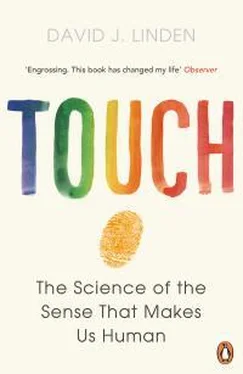Merkel cells are required in a mechanical role to transmit force properly to the nerve fiber, but it is the nerve fiber that transduces force into electrical spiking through Piezo channels. Therefore, when you remove Merkel cells, there’s no response in the nerve fiber because the ending of the fiber is not properly activated mechanically.
Merkel cells transduce force into electrical signals, and then they release a chemical signal (a neurotransmitter) to evoke an electrical signal in the nerve fiber.
When Merkel cells are removed in the mutant mouse by genetic engineering, there is a developmental side effect that makes the nerve fiber unable to transduce force into electrical signals, even though it does so in normal mice (and presumably humans, too).
While the manuscript for this book was in the editing stage, a new report appeared that shed light on this interesting problem. Genetic engineering was used to create a mouse in which the stretch-activated Piezo2 ion channel was deleted in skin cells (including Merkel cells) but not in sensory nerves. In these mice, the Merkel cells no longer had touch-sensitive electrical currents. However, the sensitivity of the glabrous skin to fine mechanical stimulation was decreased but not abolished in these mice. This suggests a two-site model for mechanotransduction in both the Merkel cells and the sensory neurons that contact them, a sort of hybrid of models (a) and (b) above. S. H. Woo, S. Ranade, A. D. Weyer, A. E. Dubin, Y. Baba, Z. Qiu, M. Petrus, T. Miyamoto, K. Reddy, E. A. Lumpkin, C. L. Stucky, and A. Patapoutian, “Piezo2 is required for Merkel-cell mechanotransduction,” Nature 50 (2014): 622-26.
17. Å. B. Vallbo, K. A. Olsson, K.-G. Westberg, and F. J. Clark, “Microstimulation of single tactile afferents from the human hand,” Brain 107 (1984): 727–49. This technique requires amazing dexterity on the part of the experimenter and great tolerance on the part of the subject. It involves manually inserting a very fine electrode (with a tip size of 0.01 millimeter) into the arm to carefully seek out a single tactile nerve fiber originating from the hand for single fiber recording and, in some cases, single fiber stimulation. These experiments can take hours to complete. Remarkably, stimulation of single mechanosensory nerve fibers can reliably give rise to both a clear perception of touch and a clear activation of certain touch-processing regions of the brain, as revealed by brain imaging or EEG recording. M. Trulsson and G. K. Essick, “Sensations evoked by microstimulation of single mechanoreceptive afferents innervating the human face and mouth,” Journal of Neurophysiology 103 (2010): 1741–47; and M. Trulsson, S. T. Francis, E. F. Kelly, G. Westling, R. Bowtell, and F. McGlone, “Cortical responses to single mechanoreceptive afferent microstimulation revealed with fMRI,” NeuroImage 13 (2001): 613–22.
18. While each Merkelending is innervated by a single sensory axon, a single axon will typically innervate 10–50 Merkel disks spread over a diameter of 1 to 3 millimeters. It may seem trivial that Merkels can respond weakly to small indentations and strongly to large ones (and do so linearly), but this turns out to be crucial for sensing the curvature of objects—in distinguishing the smooth edge of a penny from that of a nickel, for example. If we were to zoom in on your fingertip contacting the edge of a penny, what we’d see is that the skin of the fingertip is indented most strongly at the central point of contact and the degree of indentation falls off with distance as we move away from that point in both directions. Of course, the rate at which the indentation falls off with distance will be proportional to the curvature of the object—smaller for the nickel and larger for the penny. Because the dense array of Merkel disk endings can accurately report the degree of indentation at each point, sufficient information can be conveyed by a population of Merkel disk nerve fibers to allow the brain to estimate object curvature.
19. If you’re starting to suspect that German anatomists of the nineteenth century had an outsize role in describing the cellular structure of organs, you’re right. The Meissner’s corpuscle was codiscovered by Georg Meissner and his mentor Rudolf Wagner of Göttingen University, and described in an 1852 publication. The next year, Meissner published on these structures again, this time leaving Wagner’s name off the work. A bitter fight over priority ensued and the conflict remained unresolved at the time of Wagner’s death in 1864.
20. Corpuscle, from the Latin corpusculum, or “tiny body,” is an odd and vague word. In biology, it can mean either a single free-floating cell, like a red or white blood cell, or a small collection of cells into a particular structure, as in the Meissner’s corpuscle. In a humorous intersection of biology, religion, and academe, members of Corpus Christi College, Oxford, or Corpus Christi College, Cambridge, are also called corpuscles. This is the same type of linguistic collision that leads to a delightful official title for the Roman Catholic pontiff: the Supreme Primate.
21. In an inspiration to future doctors everywhere, the Pacinian corpuscle was discovered by Italian anatomist Filippo Pacini when he was still a medical student at Pistoia (a small city in Tuscany) in 1831 doing his assigned cadaver dissections. He first published his findings some years later: F. Pacini, Nuovi organi scoperti nel corpo umano , Tipografia Cino, Pistoia, Italy, 1840. The Pacinian corpuscle is also sometimes called the lamellar corpuscle, in reference to the many sheets, or lamellae, of cells that form its capsule.
22. Their concentric lamellar structure also calls to mind that great Edward Weston photograph of an artichoke in cross-section: http://www.masters-of-photography.com/W/weston/weston_artichoke_halved_full.html; or certain Georgia O’Keeffe paintings, like Grey Line with Black, Blue, and Yellow (1923): http://www.wikipaintings.org/en/georgia-o-keeffe/gray-line-with-black-blue-and-yellow.
23. Of course, earthquakes and bomb tests have characteristic frequency information as well, so in order to simulate them, jumping children would need an unusual degree of motor control. It’s a thought experiment, really.
24. L. Ulrich, “Porsche’s baby turns 16; seeks a bigger allowance,” New York Times , August 17, 2012, http://www.nytimes.com/2012/08/19/automobiles/autoreviews/porsches-baby-turns-16-seeks-a-bigger-allowance.html?pagewanted=all.
25. The Ruffini ending was first described by the Italian anatomist Angelo Ruffini: A. Ruffini, “Les expansions nerveuses de la peau l’homme et quelques autres Mammifeves,” Review of General Histology 3 (1905): 421–540.
26. The presence of Ruffini endings in the glabrous skin of the hand is still a matter of some debate. For example, they don’t appear to be present in the finger pads of the monkey, only at the base of the fingernails. M. Pare, A. M. Smith, and F. L. Rice, “Distribution and terminal arborizations of cutaneous mechanoreceptors in the glabrous finger pads of the monkey,” Journal of Comparative Neurology 445 (2002): 347–59.
27. While the nerve fibers that convey information from the mechanosensors do not blend signals from more than one type of detector, these “labeled lines” are not perfectly maintained all the way to the brain. At every relay station in the spinal cord and the brain itself, there is some degree of signal blending. As we will see in later chapters, this signal blending can also cross touch modalities: There are neurons in the spinal cord that are driven by both light touch (mechanosensation) and temperature or light touch and pain, for example.
28. Z. gets miffed if I space out and caress her arm against the grain of the hairs. “If you did that to a cat it would bite you, or at least walk away,” she says.
Читать дальше












